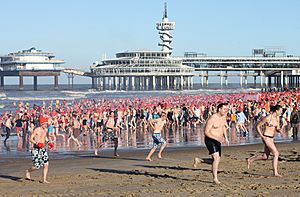New Year's Day facts for kids
Quick facts for kids New Year's Day |
|
|---|---|
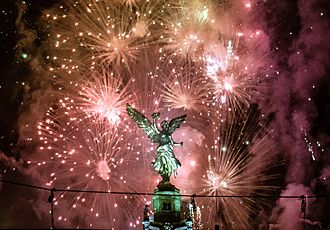
Fireworks in Mexico City for New Year 2013
|
|
| Observed by | Users of the Gregorian calendar |
| Type | International |
| Significance | The first day of the year in the Gregorian calendar |
| Celebrations | Making New Year's resolutions, church services, parades, parties, sporting events, fireworks |
| Date | 1 January |
| Next time | 1 January 2025 |
| Frequency | Annual |
| Related to |
|
In the Gregorian calendar, New Year's Day is the first day of the calendar year, 1 January. Most solar calendars (like the Gregorian and Julian) begin the year regularly at or near the northern winter solstice, while cultures and religions that observe a lunisolar or lunar calendar celebrate their Lunar New Year at less fixed points relative to the solar year.
In pre-Christian Rome under the Julian calendar, the day was dedicated to Janus, god of gateways and beginnings, for whom January is also named. From Roman times until the middle of the 18th century, the new year was celebrated at various stages and in various parts of Christian Europe on 25 December, on 1 March, on 25 March and on the movable feast of Easter.
In the present day, with most countries now using the Gregorian calendar as their civil calendar, 1 January according to Gregorian calendar is among the most celebrated of public holidays in the world, often observed with fireworks at the stroke of midnight following New Year's Eve as the new year starts in each time zone. Other global New Year's Day traditions include making New Year's resolutions and calling one's friends and family.


Contents
Modern new year celebrations

| Date | Celebration |
|---|---|
| January 1 | Christian New Year |
| January 14 | Eastern Orthodox New Year |
| January 21 | Chinese New Year (also known as the lunar year. It takes place every year on the first lunar month) |
| January 21 | Vietnamese New Year (also known as the Tết Nguyên Đán) |
| January to March | Tibetan New Year |
| March 14 | Sikh / Nanakshahi New Year (also called Hola Mohalla) |
| March 20 or 21 | Iranian New Year (also called Norouz. It is the day containing the exact moment of the vernal equinox) |
| March 19, 20, 21 or 22 | Bahá'í New Year (also called Naw-Rúz. It is the day (starting at the previous sunset) in Tehran containing the exact moment of the vernal equinox) |
| April 1 | Assyrian New Year (also called Rish Nissanu) |
| April 13 or 14 | Tamil New Year |
| March or April | Telugu New Year |
| April 13 | Punjabi New Year (also called Vaisakhi and celebrates the harvest) |
| April 13 to 15 | Thai New Year (celebrated by throwing water) |
| April 13 or 14 | Sri Lankan New Year (when the sun moves from the Meena Rashiya (House of Pisces) to the Mesha Rashiya (House of Aries)) |
| April 13 to April 15 | Cambodian New Year |
| April 14 or 15 | Bengali New Year (also called Pohela Baisakh) |
| October or November | Gujarati New Year |
| October or November | Marwari New Year |
| Muharram 1 | Islamic New Year |
Traditional and modern celebrations and customs
New Year's Eve
The first of January represents the fresh start of a new year after a period of remembrance of the passing year, including on radio, television, and in newspapers, which starts in early December in countries around the world. Publications have year-end articles that review the changes during the previous year. In some cases, publications may set their entire year's work alight in the hope that the smoke emitted from the flame brings new life to the company. There are also articles on planned or expected changes in the coming year.
This day is traditionally a religious feast, but since the 1900s has also become an occasion to celebrate the night of 31 December—New Year's Eve—with parties, public celebrations (often involving fireworks shows) and other traditions focused on the impending arrival of midnight and the new year. Watchnight services are also still observed by many.
New Year's Day
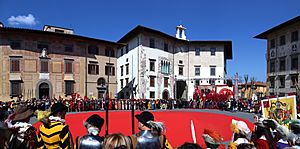
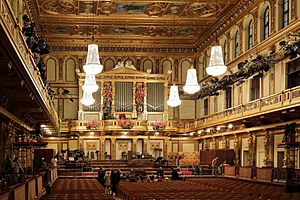
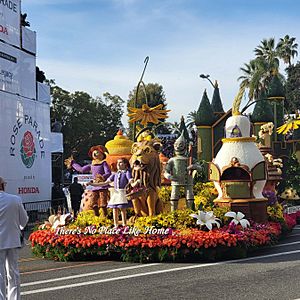
The celebrations and activities held worldwide on 1 January as part of New Year's Day commonly include the following:
- Several major parades are held on New Year's Day, including the London's New Year's Day Parade, Pasadena's Tournament of Roses Parade (also known as the "Rose Parade"), and Philadelphia's Mummers Parade. In the Bahamas, it is also associated with Junkanoos.
- Beginning in the 2010s, it is also the day that First Day Hikes takes place in the fifty state park systems of the United States.
- The Vienna Philharmonic orchestra traditionally performs a New Year's concert on the morning of New Year's Day.
- A "polar bear plunge" is a common tradition in some countries, where participants gather on beaches and run into the cold water. Polar Bear Clubs in many Northern Hemisphere cities have a tradition of holding organized plunges on New Year's Day, and they are often held to raise money for charity.
- In Ireland, New Year's Day was called Lá na gCeapairí, or the day of the buttered bread. A possible meaning to the consumption of buttered bread was to ward off hunger and famine in the coming year, by placing the buttered bread on the doorstep in the morning. Some traditions saw parties of young people calling from house to house to receive buttered bread and occasionally Poitín, or to give out buttered bread in exchange for pennies. This tradition has since died out, having been popular in the 19th century, and waning in the 1930s and 1940s.
- In Japan, Korea and areas inhabited by the Inuit, Yupik, Aleut, Chukchi and the Iñupiat, watching the first sunrise is a tradition.
- In the United Kingdom and United States, New Year's Day is associated with several prominent sporting events:
- In the United States, 1 January is the traditional date for several major post-season college football bowl games, including the Citrus Bowl in Orlando, the Outback Bowl in Tampa, the Rose Bowl Game in Pasadena, and the Sugar Bowl in New Orleans. Since 2015, the Rose and Sugar Bowl games host the semi-finals of the College Football Playoff every three seasons, and will otherwise host two of the newly-established quarter-finals beginning in 2025. Since 2008, the National Hockey League has hosted an annual outdoor game, the Winter Classic, which rotates between different host teams annually, and usually showcases a major regional rivalry. If New Year's Day falls on a Sunday, sporting events and associated festivities (such as the Rose Parade) traditionally held on New Year's Day are typically deferred to the following Monday in defense of the National Football League—which plays a Sunday gameday as normal.
- The Premier League in English football traditionally holds a fixture of matches on New Year's Day, stemming from the historic tradition of games being played over the Christmas holiday period (including, just as prominently, Boxing Day).
- The final of the PDC World Darts Championship typically falls on New Year's Day.
- The Cheltenham Racecourse holds a New Year's Day fixture, which includes the Fairlawne Handicap Chase, Dipper Novices' Chase, and Relkeel Hurdle.
- New Year's Day is a government and bank holiday in many countries.
- In the Southern United States, a variety of foods considered lucky are cooked and consumed on New Year's Day, including hopping John, red beans and rice, and collard greens.
Music
Music associated with New Year's Day comes in both classical and popular genres, and there is also Christmas song focus on the arrival of a new year during the Christmas and holiday season.
- Paul Gerhardt wrote the text for a hymn for the turn of the year, "Nun lasst uns gehn und treten", first published in 1653.
- Johann Sebastian Bach, in the Orgelbüchlein, composed three chorale preludes for the new year: Helft mir Gotts Güte preisen ["Help me to praise God's goodness"] (BWV 613); Das alte Jahr vergangen ist ["The old year has passed"] (BWV 614); and In dir ist freude ["In you is joy"] (BWV 615).
- The year is gone, beyond recall is a traditional Christian hymn to give thanks for the new year, dating back to 1713.
- In English-speaking countries, it is traditional to sing Auld Lang Syne at midnight on New Year's.
New Year's Day babies
A common image used, often as an editorial cartoon, is that of an incarnation of Father Time (or the "Old Year") wearing a sash across his chest with the previous year printed on it passing on his duties to the Baby New Year (or the "New Year"), an infant wearing a sash with the new year printed on it.
Babies born on New Year's Day are commonly called New Year babies. Hospitals, such as the Dyersburg Regional Medical Center in the US, give out prizes to the first baby born in that hospital in the new year. These prizes are often donated by local businesses. Prizes may include various baby-related items such as baby formula, baby blankets, diapers, and gift certificates to stores which specialise in baby-related merchandise.
Antarctica
On New Year's Day in Antarctica, the stake marking the geographic south pole is moved approximately 10 meters to compensate for the movement of the ice. A new marker stake is designed and made each year by staff at the site nearby.
Images for kids
See also
 In Spanish: Día de Año Nuevo para niños
In Spanish: Día de Año Nuevo para niños
- First Night
- Rosh Hashanah



